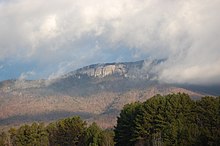Table Rock State Park (South Carolina)
| Table Rock State Park | |
|---|---|

Table Rock Mountain
|
|
| Nearest city | Pickens, South Carolina |
| Coordinates | 35°02′09.2″N 82°42′21.3″W / 35.035889°N 82.705917°WCoordinates: 35°02′09.2″N 82°42′21.3″W / 35.035889°N 82.705917°W |
| Area | 3,083 acres (12.5 km2) |
| Created | 1935 |
| Camp sites | Both regular and RV campsites Mountain cabins are also available in the park |
| Hiking trails |
|
| Other information | Pets are allowed everywhere, except the cabin areas, as long as they're on a leash |
| Website | Table Rock State Park |
|
Table Rock State Park Historic District
|
|
| Nearest city | Pickens, South Carolina |
|---|---|
| Area | 2,860 acres (1,160 ha) |
| Architectural style | Late 19th And Early 20th Century American Movements, Other, CCC construction |
| MPS | South Carolina State Parks MPS |
| NRHP Reference # | 89000478 |
| Added to NRHP | June 15, 1989 |
Table Rock State Park is a 3,083-acre (12.48 km2) park at the edge of the Blue Ridge Mountains in northern Pickens County, South Carolina. The park includes Pinnacle Mountain, the tallest mountain totally within the state.
The park features a lodge restored by the Civilian Conservation Corps (CCC) that includes a kitchen and a 72-seat dining room. There are two park lakes with seasonal swimming permitted and hiking trails that lead to the Pinnacle Mountain Summit (two routes), Mill Creek Falls, and the summit of Table Rock. A nature center offers educational programs, and there are picnic shelters and a playground.
The 1.9-mile (3.1 km) Carrick Creek Nature Trail loops around two creeks with small cascades and waterfalls and displays wildflowers in season.
The 3.5-mile (5.6 km) Table Rock Summit Trail is moderately strenuous, rising 2,000 feet (610 m) above the trailhead and includes a shelter built by the CCC. At approximately 2.5 miles (4.0 km), the trail forks, the left fork following a ridge trail to Pinnacle Mountain and the right fork to the summit at 3,124 feet (952 m). The trail ends at an overlook with a view of Table Rock Reservoir and Caesars Head.
The park is the eastern trailhead of the 80-mile (130 km) Foothills Trail through the Blue Ridge Escarpment.
Prior to the signing of the Hopewell Treaty of 1785, the land now encompassed by Table Rock State Park was part of the Lower Cherokee Nation. The Cherokee called the area, "Sah-ka-na-ga," the Great Blue Hills of God, and they established many hunting camps in the area.
Europeans moved into the Oolenoy River Valley soon after the signing of the Hopewell Treaty, settling at Pumpkintown (named for the unusually large pumpkins grown there). William Sutherland and James Keith operated a wayside lodge for visitors and in about 1840, they built a hotel, which prospered until the Civil War. Visitors increased again after Reconstruction, and in 1899, E. Foster Keith built a new hotel, which was later destroyed. By the beginning of the 20th century several farm families lived in the Table Rock area.
...
Wikipedia


